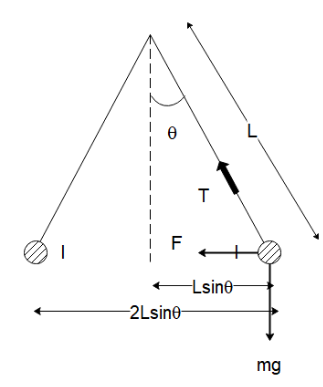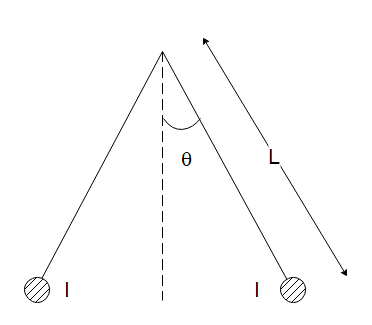
Answer
422.1k+ views
Hint : In this solution, we will determine the force acting on the two wires due to the current flowing in them. Then we will use the components of force to determine the value of $ I $ .
Formula used: In this solution, we will use the following formula:
$ F = \dfrac{{{\mu _0}{I_1}{I_2}L}}{{2\pi d}} $ where $ F $ is the force between two current-carrying wires having a current $ {I_1} $ and $ {I_2} $ , having the same length $ L $ and distance $ d $ between them.
Complete step by step answer
Let us start by drawing a free-body diagram of the force between the current-carrying cable.

As we can see, the forces balanced in the horizontal direction will be
$ T\sin \theta = F $
And in the vertical direction will be
$ T\cos \theta = mg $
Diving both these equations, we get
$ \tan \theta = \dfrac{F}{{mg}} $
The mass of the strings can be determined as the product of the linear mass density and the length of the rod. So, we have
$ m = \lambda L $
Now, the force between the two current-carrying cables $ ({I_1} = {I_2} = I) $ which are placed a distance $ 2L\sin \theta $ apart will be
$ F = \dfrac{{{\mu _0}{I^2}L}}{{2\pi 2L\sin \theta }} $
Substituting the value of force in equation (1), we get
$ I = 2\sin \theta \sqrt {\dfrac{{\pi \lambda gL}}{{{\mu _0}\cos \theta }}} $ which corresponds to option (B).
Note
We must carefully infer from the diagram that the current-carrying cables are placed perpendicular to the plane of the page. Since we only want to find the magnitude of the force, the direction of the current in the cables is inconsequential to us.
Formula used: In this solution, we will use the following formula:
$ F = \dfrac{{{\mu _0}{I_1}{I_2}L}}{{2\pi d}} $ where $ F $ is the force between two current-carrying wires having a current $ {I_1} $ and $ {I_2} $ , having the same length $ L $ and distance $ d $ between them.
Complete step by step answer
Let us start by drawing a free-body diagram of the force between the current-carrying cable.

As we can see, the forces balanced in the horizontal direction will be
$ T\sin \theta = F $
And in the vertical direction will be
$ T\cos \theta = mg $
Diving both these equations, we get
$ \tan \theta = \dfrac{F}{{mg}} $
The mass of the strings can be determined as the product of the linear mass density and the length of the rod. So, we have
$ m = \lambda L $
Now, the force between the two current-carrying cables $ ({I_1} = {I_2} = I) $ which are placed a distance $ 2L\sin \theta $ apart will be
$ F = \dfrac{{{\mu _0}{I^2}L}}{{2\pi 2L\sin \theta }} $
Substituting the value of force in equation (1), we get
$ I = 2\sin \theta \sqrt {\dfrac{{\pi \lambda gL}}{{{\mu _0}\cos \theta }}} $ which corresponds to option (B).
Note
We must carefully infer from the diagram that the current-carrying cables are placed perpendicular to the plane of the page. Since we only want to find the magnitude of the force, the direction of the current in the cables is inconsequential to us.
Recently Updated Pages
How many sigma and pi bonds are present in HCequiv class 11 chemistry CBSE

Mark and label the given geoinformation on the outline class 11 social science CBSE

When people say No pun intended what does that mea class 8 english CBSE

Name the states which share their boundary with Indias class 9 social science CBSE

Give an account of the Northern Plains of India class 9 social science CBSE

Change the following sentences into negative and interrogative class 10 english CBSE

Trending doubts
Which are the Top 10 Largest Countries of the World?

Difference between Prokaryotic cell and Eukaryotic class 11 biology CBSE

Why is October 161905 regarded as an important day class 10 social science CBSE

Fill the blanks with the suitable prepositions 1 The class 9 english CBSE

Which river is known as Ganga of the south A Krishna class 11 social science CBSE

Give 10 examples for herbs , shrubs , climbers , creepers

Difference Between Plant Cell and Animal Cell

Differentiate between homogeneous and heterogeneous class 12 chemistry CBSE

Change the following sentences into negative and interrogative class 10 english CBSE




